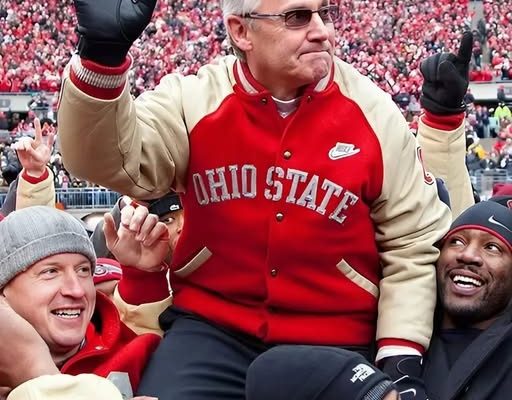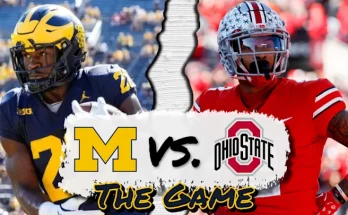The story of Woody Hayes and his Ohio State Buckeyes is not merely a tale of football dominance; it is a portrait of an era defined by relentless grit, unshakable loyalty, and the unbreakable bond between a coach and his players. It is a chronicle of iron-willed discipline meeting fierce love of school and team, and of how one man’s singular vision helped shape one of the most revered dynasties in college football history. The golden era of Ohio State football under Hayes didn’t just produce victories—it forged a legacy, cultivated a brotherhood, and captured the spirit of an entire state.
When Wayne Woodrow “Woody” Hayes took over the Ohio State football program in 1951, he inherited a proud but inconsistent team still trying to reclaim national relevance. The pressure was immense. Ohio State had already tasted glory under Paul Brown a decade earlier and expected to be a perennial powerhouse. But Hayes was no ordinary hire. A fiery World War II Navy veteran, Hayes brought with him a militaristic approach to coaching that emphasized toughness, preparation, and an obsession with fundamentals. It wasn’t flashy. It wasn’t modern. But it worked.
Hayes’s football philosophy was grounded in “three yards and a cloud of dust”—an often-mocked but brutally effective brand of football built on the power running game, field position, and crushing defense. His disdain for passing the ball was famous. “There are three things that can happen when you pass,” he famously said, “and two of them are bad.” But beneath the gruff exterior and old-school ideology was a coach who was a fierce intellectual, a voracious reader, and a teacher as much as he was a football tactician. And his players? They weren’t just athletes. They were soldiers in a cause bigger than themselves. Hayes forged them into warriors who would come to embody the very soul of Ohio State football.
One of the defining characteristics of Hayes’s tenure was his ability to motivate his players not through pampering, but through challenge. His practices were notoriously grueling. His standards, impossibly high. But if you could survive Woody Hayes, you were better for it. You didn’t just become a football player. You became a Buckeye. That was a distinction that carried immense pride. Hayes didn’t merely coach men—he transformed boys into leaders. He believed in molding character as much as he did building rosters. And in return, his players would go to war for him on Saturdays, wearing the scarlet and gray like armor.
The success didn’t come overnight. Hayes’s early years in Columbus were rocky, with critics quick to call for his dismissal after a few up-and-down seasons. But in 1954, everything clicked. That year, Ohio State ran the table, going undefeated and winning the national championship. The Buckeyes were back, and Hayes had firmly stamped his authority on the program. He would go on to win four more national titles and thirteen Big Ten championships, cementing Ohio State as one of the premier programs in the country. Yet, beyond the hardware, it was the culture Hayes created that became his true legacy.
At the heart of the Buckeye Brotherhood was an unwavering sense of loyalty—to the team, to the school, and to the ideals Hayes preached. His players were expected to play not for themselves, but for each other. Hayes created a culture in which sacrifice was not just expected, but embraced. Seniors mentored freshmen. Injured stars cheered louder than anyone on the sidelines. Victory was communal, and so was suffering. This ethos resonated deeply with the people of Ohio, a state known for its hard-nosed work ethic and love of football. In many ways, Woody Hayes wasn’t just the coach of Ohio State. He was the embodiment of Ohio itself.
The list of legendary players who passed through Hayes’s program is a who’s who of Buckeye greatness. Names like Archie Griffin, Rex Kern, Jack Tatum, John Hicks, Chris Ward, and Jim Otis—all products of the Woody Hayes system. Each brought unique talent, but all shared the same values instilled in them by their coach. Of these legends, perhaps none was more iconic than Archie Griffin, the only two-time Heisman Trophy winner in college football history. Griffin’s humility, work ethic, and consistent greatness perfectly embodied the Buckeye ideal. Hayes loved him not just for his ability, but for his character. That was the hallmark of a true Hayes recruit.
Hayes also created one of the most ferocious rivalries in all of sports. The Ohio State-Michigan rivalry reached a fever pitch under his tenure, particularly during the infamous “Ten-Year War” against former assistant and then Michigan head coach Bo Schembechler. These titanic clashes defined an era of Big Ten football and often determined the conference champion. The stakes were immense. The emotion, raw. Hayes’s hatred of Michigan wasn’t just football theater—it was deeply personal, bordering on the fanatical. He once famously refused to use the word “Michigan,” calling it “That School Up North.” The rivalry games under Hayes weren’t just games—they were battles, and no one wanted to win them more than Woody.
But even the most storied eras come with blemishes. Hayes’s career came to a sudden and ignominious end in 1978 after he punched a Clemson player during the Gator Bowl. It was a moment of uncontrolled emotion that overshadowed decades of service, excellence, and mentorship. Hayes was fired the next day, bringing his remarkable coaching journey to an abrupt conclusion. But time has softened the view of that incident, and most Buckeye faithful remember Hayes not for how it ended, but for what he built.
His impact went far beyond wins and losses. Hayes was a mentor to countless young men, many of whom went on to successful careers in and out of football. He was a voracious promoter of education, famously saying, “You win with people.” He read constantly, quoted philosophers, and emphasized to his players the importance of intellectual development. He pushed them to succeed in the classroom as much as he did on the field. For Hayes, football was the vehicle, but life was the destination. And that made all the difference.
Today, decades after his departure, Woody Hayes remains an almost mythical figure in Ohio State lore. His image graces the walls of the Woody Hayes Athletic Center. His name is invoked with reverence at alumni gatherings. And the lessons he taught continue to influence the program. His fingerprints are everywhere—from the toughness still evident in the Buckeyes’ playing style to the reverence with which players and coaches speak about the “brotherhood.” The culture of accountability, of team-first mentality, of tradition and pride—all of it stems from the Hayes era.



